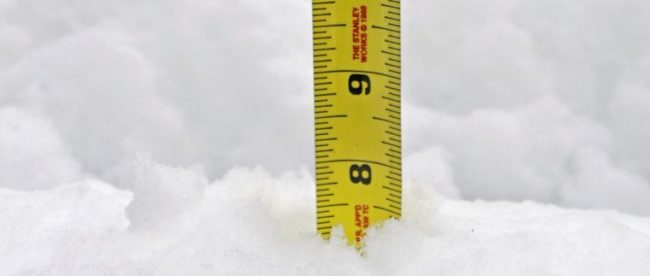There’s Snow Better Way to Measure

While we can’t change the weather (yet?), we, as a society, have made extraordinary strides in predicting what’s happening next. There are definitely glitches and mistakes, sure, and there are also limitations to what we can successfully predict. On the other hand, getting data after-the-fact is something we’ve mastered: if you want to know how hot it was yesterday or how intense a storm was, we have a lot of computers and seemingly magical monitoring tools which give data scientists the ability to measure that in real-time, creating a record for history.
But when it comes to measuring snowfall, technology isn’t the answer. There’s no great way to measure the net effect of snowstorms from a distance — as an example, the satellites used to observe storms don’t also tell you how much snow they dump on the ground. So what is the National Weather Service to do?
They ask for help. Volunteers, just like you and me.
In 1890 — yes, over a century ago — the U.S. Congress formed what’s now known as The Coop. Per its website, the Coop has two goals: “to provide observational meteorological data, usually consisting of daily maximum and minimum temperatures, snowfall, and 24-hour precipitation totals” and “to provide observational meteorological data in near real-time to support forecast, warning and other public service programs of the NWS.” In other words, The Coop’s job is to figure out what just happened so that the Weather Service can turn it into useful info for tomorrow.
To do that, the Coop asks everyday people to help. The Weather Service has thousands of places from which they’d like data collected, and there’s simply no way they can gather data, by hand, using the National Weather Service’s existing staff. The solution: a massive, nationwide volunteer network of rain and snow watchers — as Quartz reports, “there are over 8,700 cooperative observers across the country who send in their weather data to the NWS daily.” Those data gatherers measure what they can measure, and their colllective work becomes our official weather stats.
For snow, the process is, basically, as simple as sticking a ruler into the ground and reporting how many inches of snow have accumulated — just like a curious nine-year-old would do on a snow day. The only major difference is that National Weather Service volunteers are asked to use a “snowboard,” which isn’t a reference to one of these. Rather, as the NWS states, it’s “just a piece of plywood (ideally 16 X 16 inches), which you place on the ground and use as a base for your snow measurements.” (But it’s critical “because it gives you a hard, flat surface on which to get accurate snow measurements from.”)
There are some complications here or there — how do you measure snowfall when there’s already snow on the ground, what if it melts before you get there, and more. But don’t worry: all NWS Coop volunteers go through a training program so they know how to measure precipitation correctly.
Want to get involved? You may be able to, based on local demand. More information can be found here.
Bonus fact: The first snowboards weren’t called snowboards. They were called “snurfers,” a portmanteau of “snow” and “surfer.”
From the Archives: Umbrella Lottery: What does an X% chance of rain mean, anyway?
